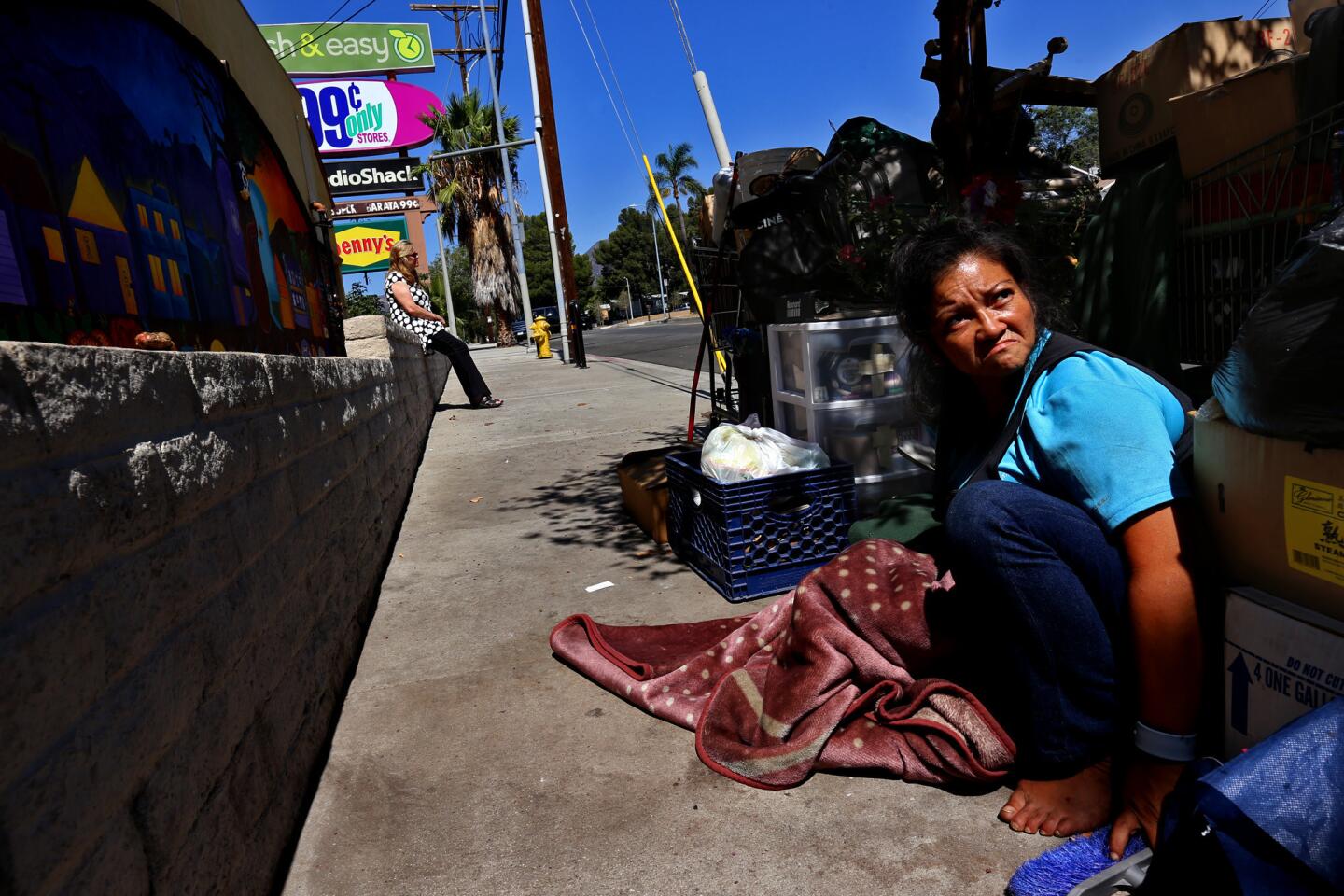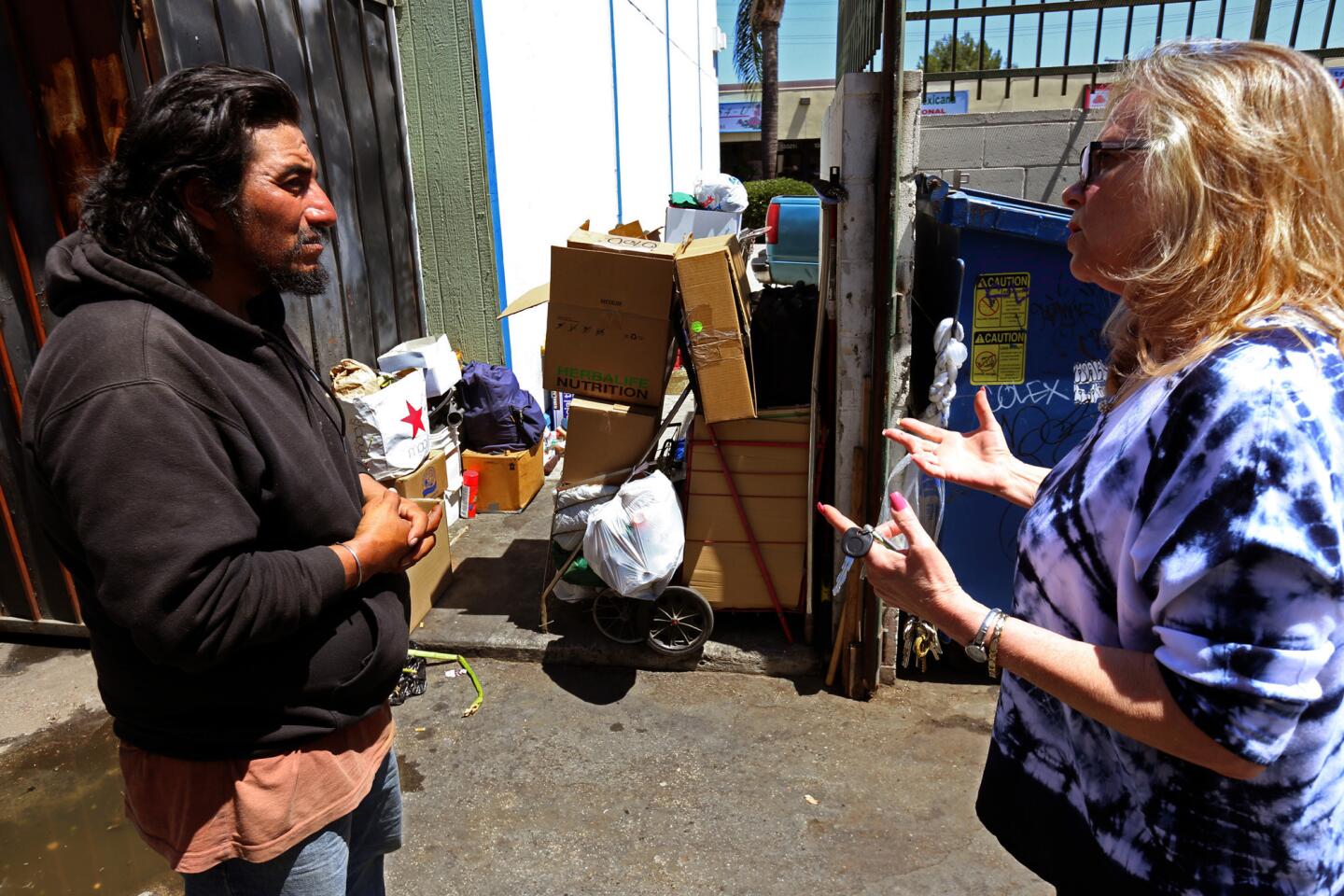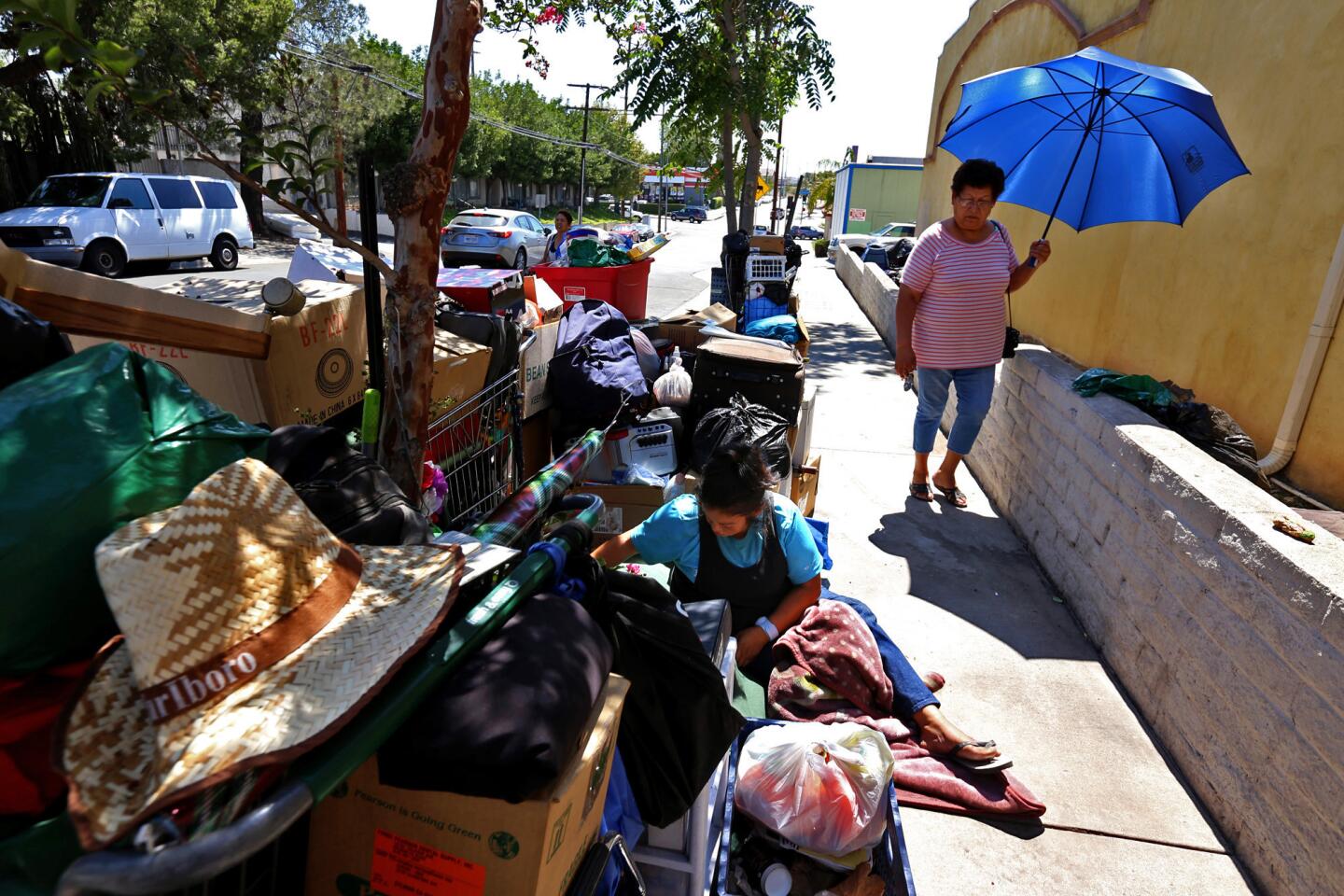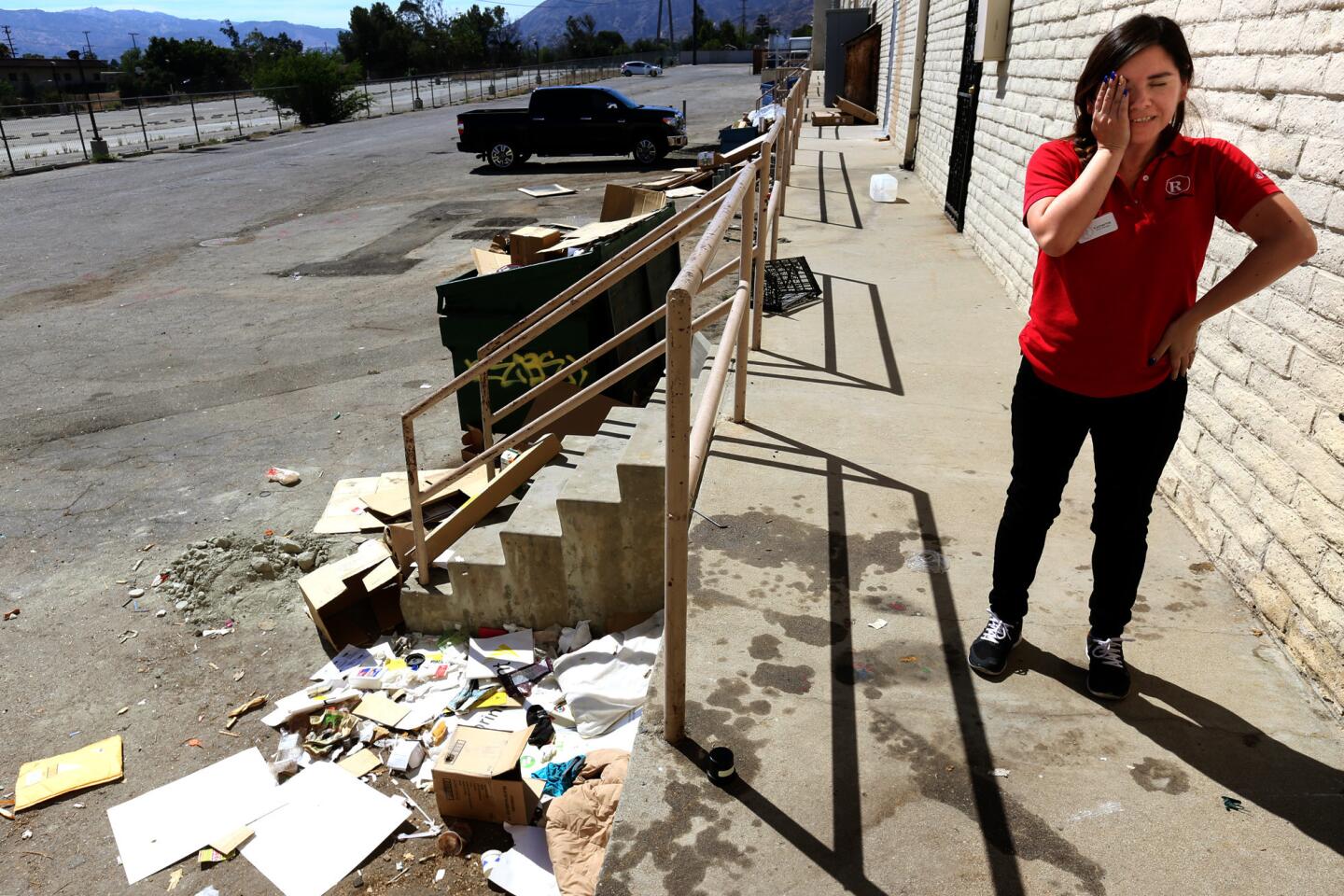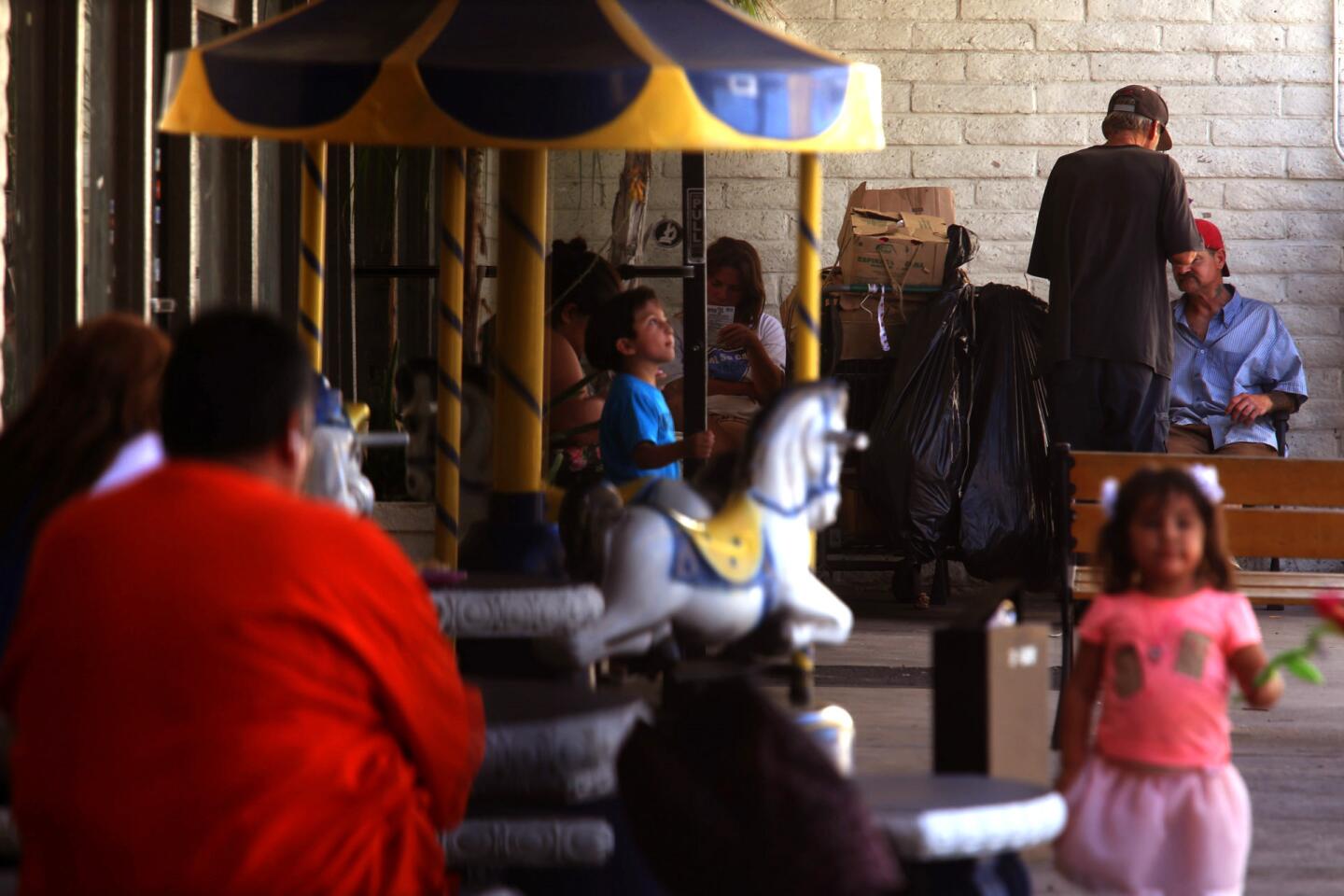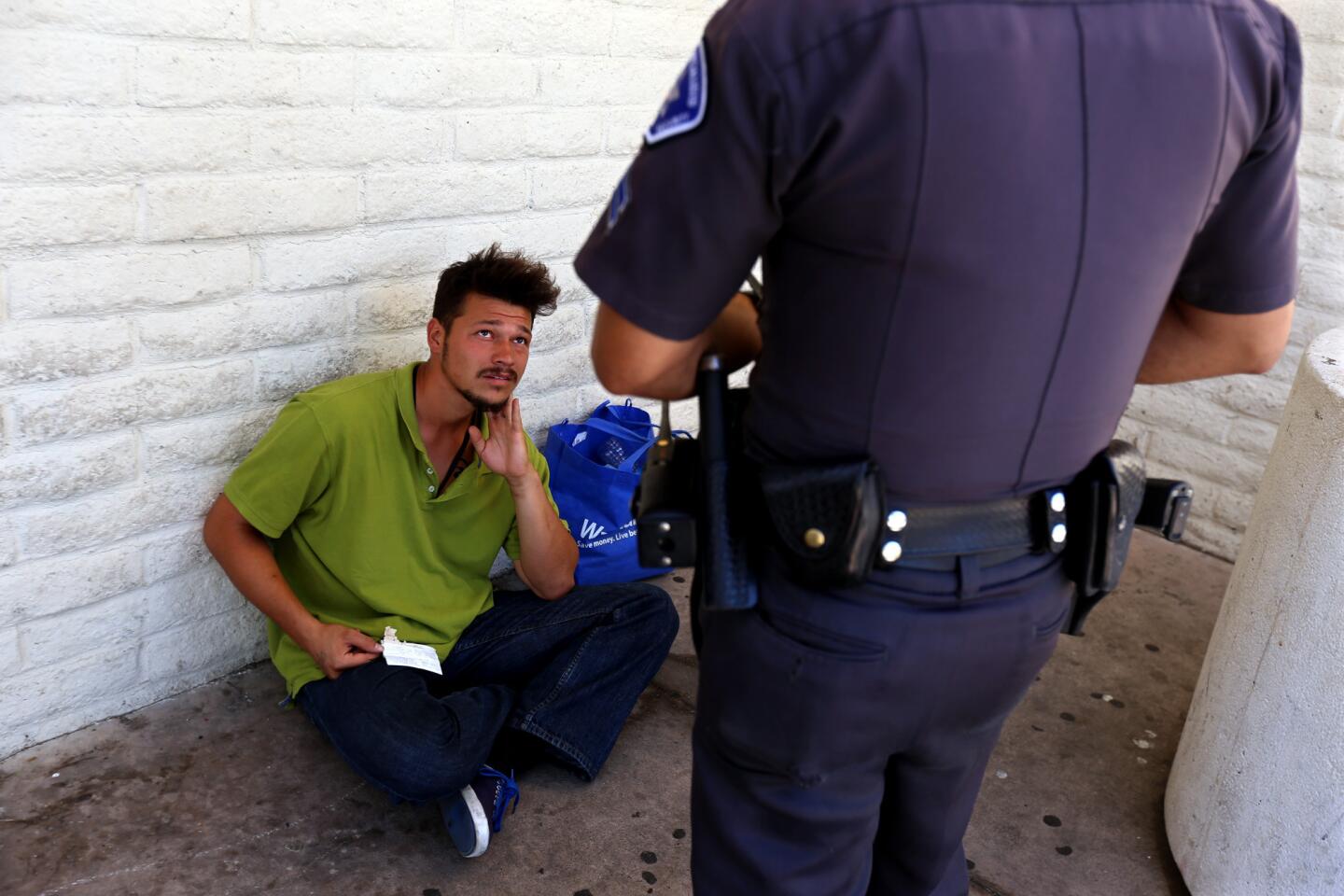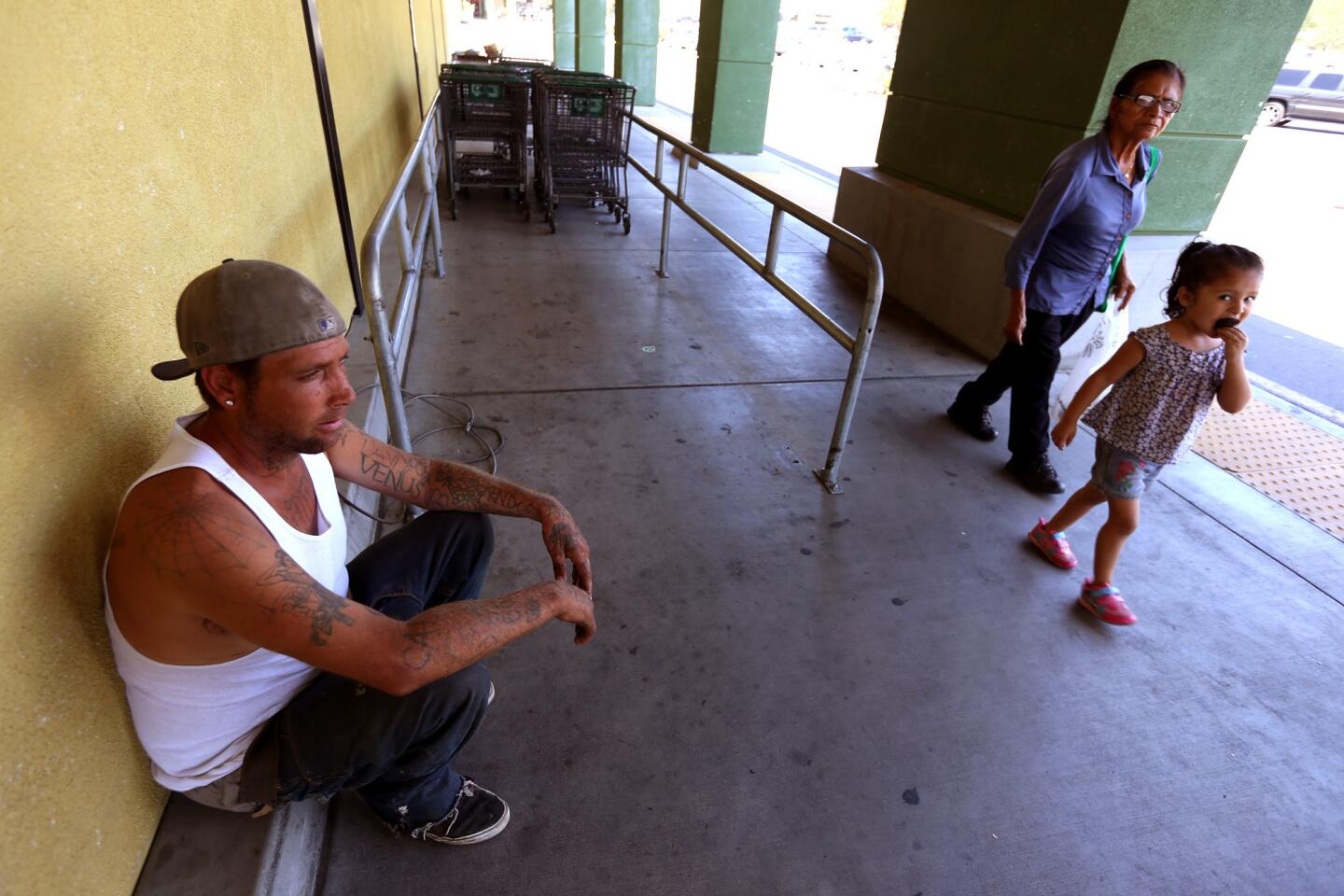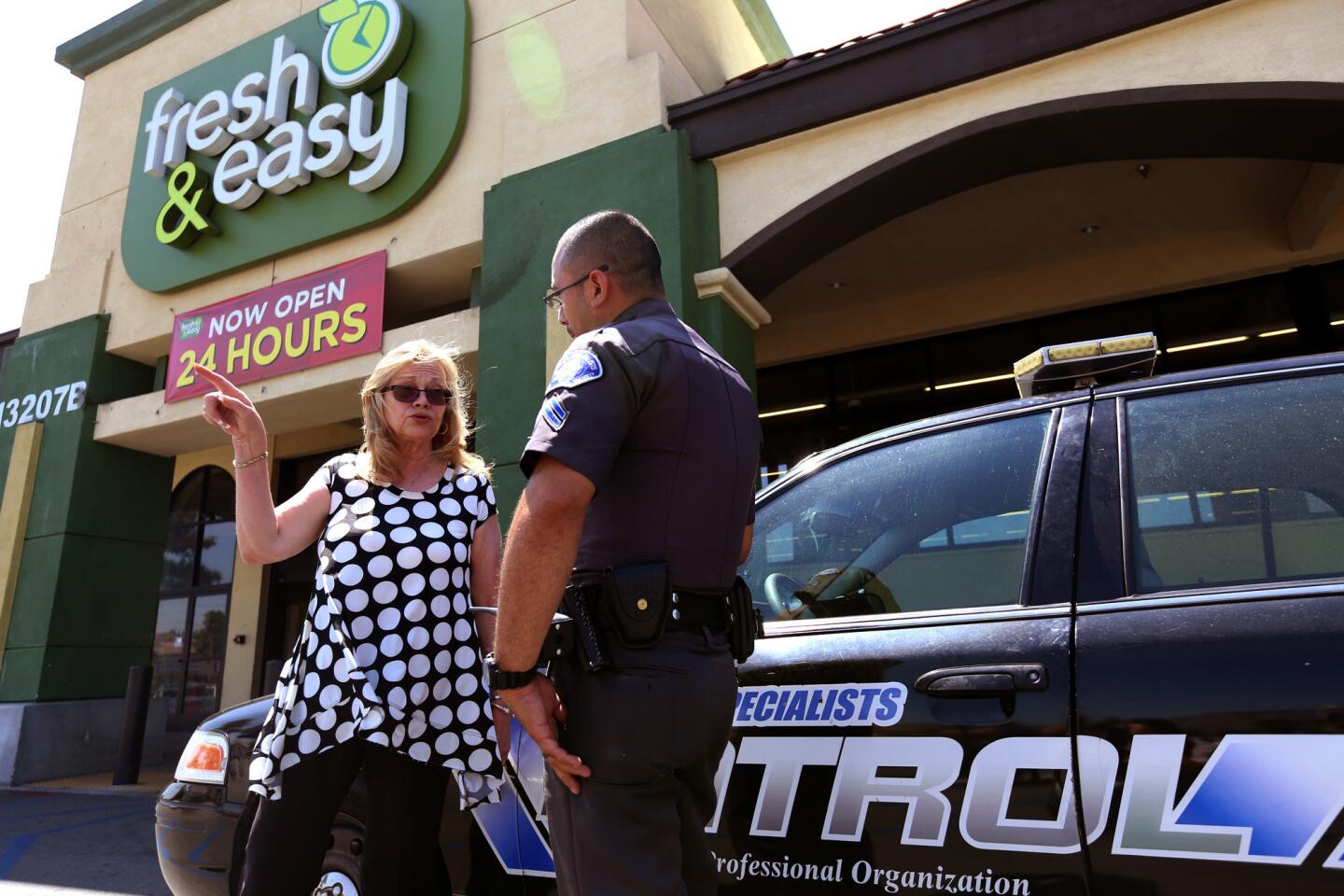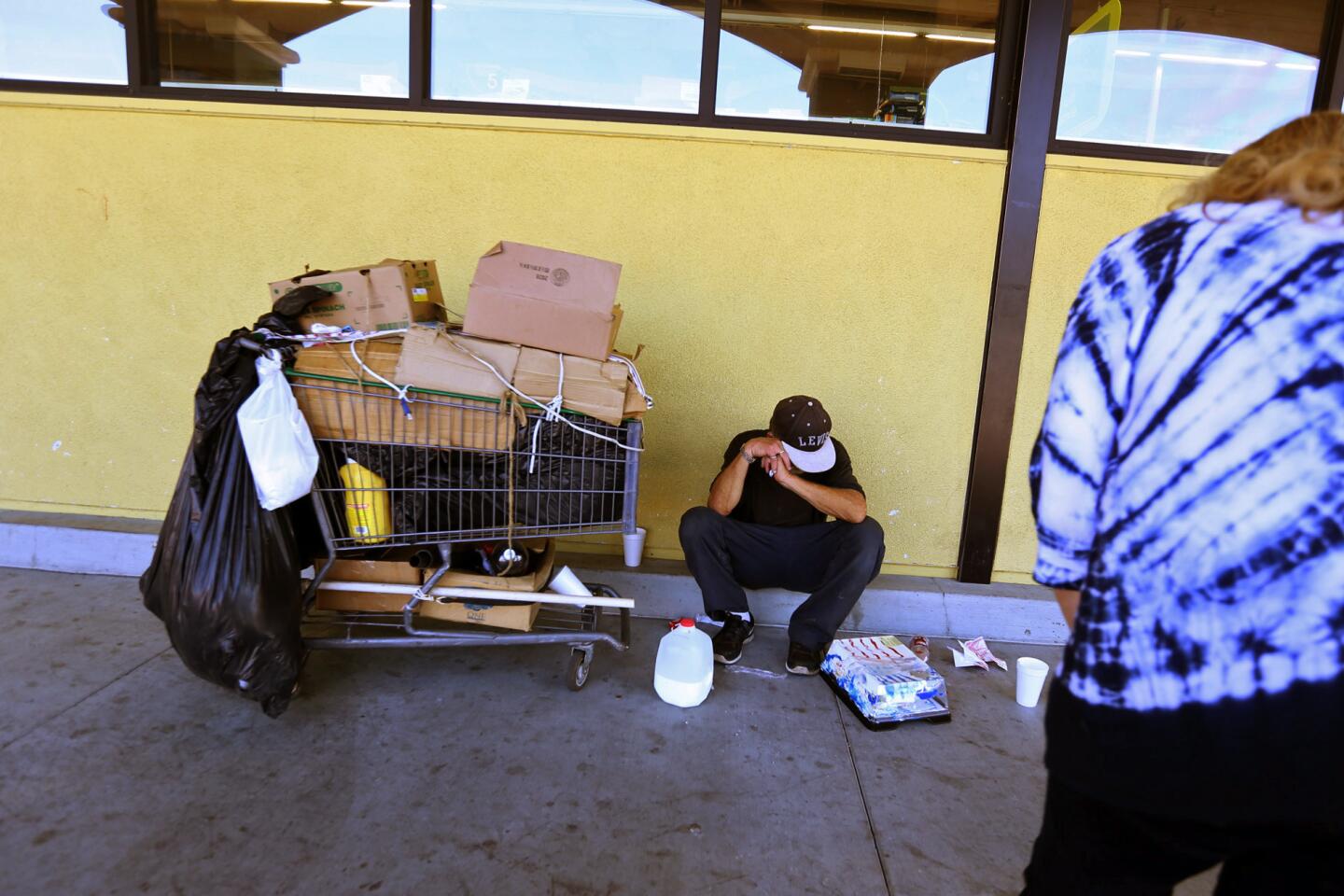Great Read: Retailers are exasperated -- and empathetic -- over number of homeless streaming to Sylmar strip mall
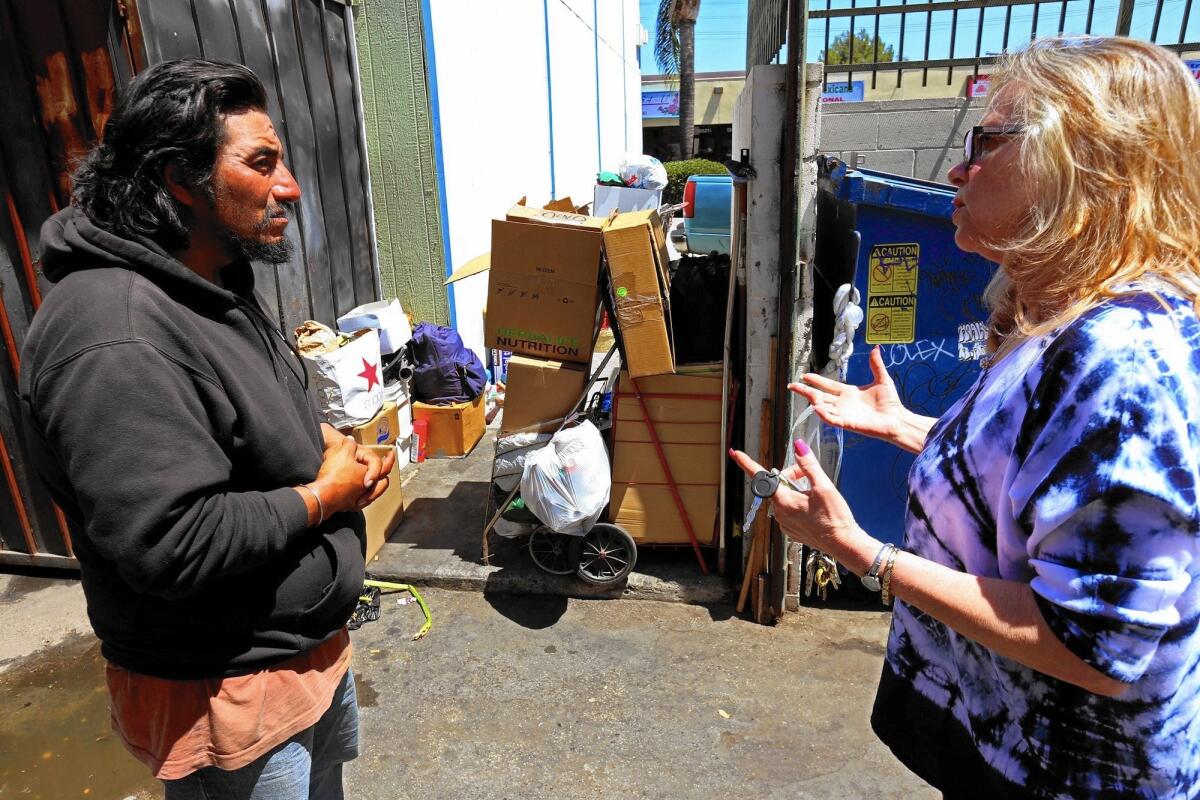
Florist shop owner Bonnie Bernard, right, talks with Angel, a homeless man who has been living with his wife across the way from Bernard’s store in a Sylmar shopping center.
- Share via
Florist shop owner Bonnie Bernard found him sitting behind a dumpster at the Sylmar strip mall, wearing a hoodie in the mid-July heat and staring at a cinder-block wall.
He was new. Was he going to be one of the scary ones?
“How long have you been here?” she asked.
He slipped the hood off his head, revealing a greasy black mane and an ingratiating smile.
“A week,” he said. His name was Angel.
In fractured English, Angel said he had lost his construction job in North Hollywood and had to leave his home. He couldn’t explain how he and his wife, Cecilia, had ended up at the Gladstone shopping center in the northern reaches of the San Fernando Valley.
That’s often the way it is with the uninvited who are making their way in ever-growing numbers to the block-long cluster of businesses just north of the 210 Freeway. They appear from somewhere, find a spot for their shopping carts filled with belongings, then settle in.
Business wasn’t brisk that day at her shop, Flowers 4-U, so Bernard was taking time out for a mission: drumming up support for her campaign to get an armed guard.
“Pretty soon the owner is going to have a guard come here and he’s going to tell you to leave,” she told Angel. “What are you going to do then?”
Bernard wanted Angel gone, but she didn’t want him harmed. It’s a conflict she and the other merchants at the center struggle with: She’s alarmed by the filth and lawlessness of the homeless encroachments, and yet she feels compassion and even a closeness for some of the longtimers. Bernard knows them, their life stories and personalities, like a second set of customers at the store she’s owned for more than 23 years.
There’s Jacob, the teenager who always asks if anyone has seen his mother, who is also homeless.
There’s Max, the scary one with the pit bull.
There’s Tatiana, the Russian, who serves as a sort of social director for the others.
And there are the nameless, too, like the man whose leg was mauled by Max’s pit bull and has not been seen since.
Richard, one of the old-timers, also was on Bernard’s mind. She said he had checked himself out of nearby Olive-View UCLA Medical Center to return to the streets, where, she feared, he had died as he wanted to, alone with his dog.
At every stop in her circuit of the shopping center’s architectural jumble, she asked: “Have you seen Richard?”
::
The Gladstone center is one small piece of the landscape of homelessness in Sylmar, a semirustic community of 90,000 once known for its vast olive orchards. And Sylmar is just a small part of the picture in L.A.’s outstretched suburbs, where services are thin, leaving residents and businesses largely on their own to adapt to an increasing intrusion in their lives.
The 2015 count by the Los Angeles Homeless Services Authority found 472 people living on the streets of Sylmar. Residents and business owners say that number represents a dramatic increase in the past two years.
The response to the spread of the city’s homeless population from its better-known concentration in downtown’s Skid Row to places such as Sylmar is an inherently conflicted grab bag of public and private activities that blend humanitarian and self-interested motives.
Several churches conduct food banks. A Los Angeles Police Department “transient” car patrols the area to get to know the homeless and work with residents and business owners to solve health and safety problems. Outreach counselors from homeless agencies offer services, which are most often declined.
The homeless people form their own society, splitting into groups, staking out turf, some disappearing in the day, others sitting and panhandling or just watching life go by. One even died in front of the shopping center’s thrift store.
“They help each other, Bernard said. “And they steal from each other, too.”
::
On Bernard’s first stop, at the Fresh & Easy anchoring the eastern end of the shopping center, manager Lupe Velazquez said she had caught Max and Tatiana having sex in the bathroom. She suspected drug deals were going on there, too. Her maintenance man had found a bag of something in the dislodged air conditioning duct.
She said she hadn’t received much support from Frank Mushmel, the owner of the center.
“Basically he just tells us to call the police,” she said. “They chase them away. The cops were just here. But it doesn’t matter, they’ll be back.”
“Let me ask you,” Bernard asked Velazquez before leaving. “That place over by the fence, that was Richard’s spot, wasn’t it?”
“Yeah, it still is,” Velazquez said.
“Really? I thought he was dead.”
::
On the west side of the center, 99 Cents Only Store manager Sergio Saucedo told Bernard he had forged a detente with one group of homeless living under a solitary tree in the alley behind the store.
Every night he fills a shopping cart with out-of-date yet edible packaged foods.
He leaves it beside a locked steel cage that had been a target of nightly raids. They would break the lock to get the rotting produce.
Saucedo reported the plan to his district manager, who he said couldn’t approve it because the company has a policy of not giving donations.
But he turned a blind eye.
“They’ve been all right with it,” he said.
The truce has done little, though, to manage the aggressive panhandlers, like the man with two horns tattooed on his head.
“Some of them are violent,” he said. “We ask them to leave. We get cussed at. It gets ugly.”
Bernard asked about Richard.
“I saw Richard maybe about two weeks ago,” he said.
“So he’s alive. Good.”
::
I feel bad for people who should have a place to stay ... But at the same time I’m afraid because I never know how they’re going to react.
— Katherine Velasco, store manager of a Radio Shack in Sylmar
The sole faucet on the long, sun-baked southern loading dock is near the back door of the Radio Shack. It has no handle, and its brass is polished by the hands of the homeless who have learned how to open it.
Katherine Velasco, the 26-year-old store manager, can hear them through the door.
She won’t go out.
“I feel bad for people who should have a place to stay,” she said. “But at the same time I’m afraid because I never know how they’re going to react. I’m pretty sure they only want to eat and wash. But you can’t be sure.”
Her employees urge her to call the police.
“I don’t have the heart to do that,” Velasco said. “I really hope someone can do something to help them out. But at the same time I don’t want to open the door and find somebody who is aggressive.”
::
Bernard’s rounds came to an end in the back lot of the shopping center, where Do-It Recycling operates a collection center. It’s nothing but a beer-scented lean-to with a cash register alongside several large padlocked bins -- and a magnet for the homeless. They come bearing bags of plastic or aluminum, take their reward of $7 to $10, and go, manager David Calderon said.
Once in a while, they break the padlocks, steal a bag of cans and take it to another recycling center to sell.
The recycling center is also a magnet for news. Lissett Reynaga, who works at the thrift store with her mother, Silvia, was hanging out with Calderon. She told Bernard the latest on Jacob.
“Jacob has a bike and he has a girlfriend and he has a dog,” Reynaga said.
“Do you know who Richard is?” Bernard asked.
“He’s under the tree,” Reynaga said.
“Is he alive?”
“Absolutely, he’s got his little garden there. I saw him yesterday morning.”
Bernard couldn’t restrain a smile.
“I thought he died because he kept getting sent to Olive View.”
“Right now he’s all right,” Reynaga said. “He stopped drinking a year ago.”
But he’s lost his Chihuahua.
“He left the little dog outside at Denny’s. He went to the bathroom.”
::
Bernard walked to the edge of the parking lot, where she found a small, shaded alcove with a garden, a throw rug on the ground, and a lean-to and a couch.
A slender, sun-parched figure with a shock of gray-blond hair wrapped by a bandanna sat on the couch.
Richard was home.
He greeted his guests with a smile, proudly showed off his stenciled painting of the Zig-Zag man, offered vegetables from his garden and bragged about his solar lights.
“I got those at the 99-cent store for a buck apiece.” he said. “The tomato plants look good at night when they’re lighted up.”
He said he’s lived there three years but doesn’t consider it permanent.
“Next year I plan on taking off,” he said. “I’m going to get me three horses and take them across the United States.”
::
Two weeks after Bernard called on her fellow merchants, owner Mushmel hired Security Specialists , a private security firm.
With the introduction of regular patrols and swift response by uniformed and armed private security guards, the shopping center adopted a zero-tolerance status.
A tattooed man in dirty jeans sat down in front of Fresh & Easy, and Cpl. Johnny Cardoza of Security Specialists was summoned. Within minutes he had issued the man a warning and sent him on his way.
The feeling of relief around the shopping center was palpable. Saucedo, the 99 Cents Only Store manager, said he no longer needed to leave out a cart of food every night to keep the homeless from breaking into his trash for scraps.
“They’re gone,” he said.
Angel and Cecilia did not go easily. They moved their belongings to the sidewalk on Gladstone Avenue and refused to leave. They were warned and then arrested by Protective Services. They didn’t show up for their court dates, so they were arrested again, along with Jacob.
Jacob has returned, but no one has seen Angel or Cecilia.
Richard wasn’t rousted, but he has disappeared. His brother Tracy is now holding down his space. Tracy said Richard was in Las Vegas. But he wouldn’t say why.
“I don’t talk to the newspapers,” he said.
MORE GREAT READS
Tethered by a string and trust, a blind sprinter and his guide make history
In India, the slow (slow) death of a black-and-white film maker
Survivors tell the camera the hidden tale of China’s Great Famine
More to Read
Sign up for Essential California
The most important California stories and recommendations in your inbox every morning.
You may occasionally receive promotional content from the Los Angeles Times.
